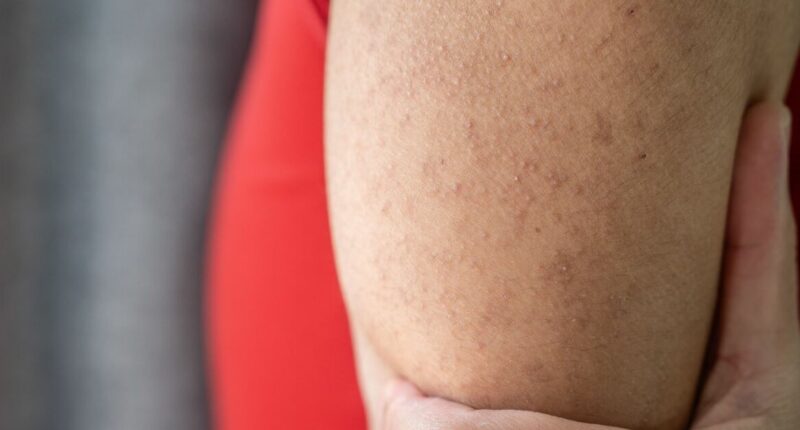Share this @internewscast.com
Many individuals have encountered what is colloquially known as “chicken skin,” with this term referring to the tiny red bumps that often appear on the arms and legs. Officially, this condition is called keratosis pilaris (KP). Although completely harmless, it can lead to feelings of self-consciousness for those affected.
The National Health Service (NHS) describes KP as a “very common harmless condition where small bumps appear on your skin. It can last for a long time, but there are treatments that may help.” Fortunately, this condition is not contagious, meaning it cannot be spread from person to person. Interestingly, the symptoms often seem more pronounced during the winter months than in the summer.
Keratosis pilaris manifests through symptoms such as itchy, dry, and rough skin, along with small, painless bumps. These bumps usually appear in clusters and match the color of your skin, often showing up on areas like the arms, thighs, or buttocks. However, they can also appear elsewhere. The bumps may appear red on lighter skin tones and darker on brown or black skin.
The cause of keratosis pilaris lies in the blockage of hair follicles due to a buildup of keratin, a protein found in the skin, hair, and nails. While the exact reason for this keratin buildup remains unknown, the condition appears to be hereditary. This means that if your parents have it, you might too. Although it may persist for several years, it often resolves on its own over time. The NHS suggests that there are steps you can take to improve the skin’s appearance despite the condition.
Despite its prevalence, keratosis pilaris can be mistaken for other skin conditions with similar appearances. Boots, a well-known pharmacy chain, highlights the importance of distinguishing KP from other conditions. They recommend consulting a pharmacist or GP for an accurate diagnosis and appropriate management strategies if there is any uncertainty.
What can be mistaken for keratosis pilaris?
WhilseKP is a common common, you may mistake it for other conditions that look similar. Boots have listed just some conditions that it could be mistaken for. It further stresses that “if you’re not sure whether you have KP, a pharmacist or GP can help confirm the diagnosis and suggest suitable ways to manage your skin.”
-
Folliculitis looks like red or white-headed pimples around hair follicles, but unlike KP, it’s often caused by an infection and can feel tender or itchy.
-
Eczema (atopic dermatitis) tends to cause red, inflamed and itchy patches of skin. While KP bumps are usually painless and dry, eczema can be more widespread, sometimes with oozing or crusting.
-
Seborrheic keratosis appears as raised, wart-like or waxy growths. Unlike KP, these tend to be larger, with a stuck-on look, and aren’t linked to hair follicles.
-
Psoriasis can cause thick, scaly patches of skin that can be itchy or sore. The plaques are well-defined and covered with silvery scales, whereas KP bumps are much finer and rougher to the touch.
How to get rid of keratosis pilaris
Do this…
-
moisturise your skin – ask a pharmacist what’s most suitable for you
-
use mild and unperfumed soaps and bathing products
-
gently scrub your skin with a washcloth or exfoliating mitt
-
have cool or lukewarm showers and baths
Choosing the right cream can be key. Experts at Boots suggest choosing a moisturiser and applying it regularly, calling it “one of the best ways to help with KP.” It adds: “Emollients, creams, lotions and ointments contain oils that help keep skin soft and hydrated. However, when these products come into contact with clothing, bedding or dressings, they can make the fabric more flammable. Even when the product has dried, there is still a risk that the material could catch fire more easily.
“If you use emollients or other skincare products, it’s important to be extra careful around naked flames, open fires, and lit cigarettes. To help reduce the risk, wash clothing and bedding regularly, ideally daily if they’ve been in contact with emollients. While washing can help, it may not remove the risk completely, even at high temperatures, so caution is still needed.
“Some moisturisers also contain ingredients like salicylic acid, lactic acid or urea, which gently exfoliate while locking in moisture. Applying a moisturiser at least twice a day, especially after showering when your skin is still damp, can help prevent dryness from making KP more noticeable.”
Don’t do this…
-
do not use perfumed soaps or bathing products that can dry out your skin
-
do not use harsh scrubs on your skin – this can make it worse
-
do not have hot baths or showers
-
do not scratch, pick or rub your skin
Treatments for keratosis pilaris
The NHS states: “Other treatments available for keratosis pilaris include steroid creams and laser treatments. These types of treatments are not usually available on the NHS because they have not been proven to be effective, and they can be expensive to pay for privately.”
The NHS suggests speaking to a pharmacist if you’ve tried to get rid of it and things are not working, especially if the condition is affecting you. You should also contact them if your skin becomes itchy or inflamed, and if you’re unsure whether you need to see a GP.
Depending on your circumstances, the pharmacist may suggest you see your GP and offer advice, but they may also be able to give you a cream to see if that helps at all, saving you time from visiting the GP.















